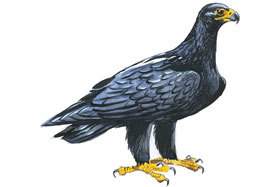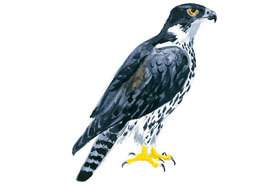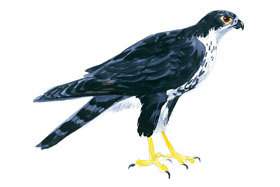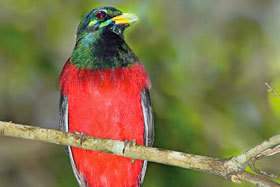

Birding Map of Kruger Park Far North Region
Pafuri Area
Pafuri is the deep north . In the words of Southern African Birdfinder author Callan Cohen, 'arguably the most exciting birding in Kruger' is to be had here. That's because of the tropical richness of the vegetation and the fact that this area is the southern limit of many Afro-tropical bird species common north of the Limpopo, but rarely seen in South Africa. These include the Tropical Boubou, Racket-tailed Roller and Meves's Starling. The Pafuri area includes the Luvuvhu River drives, the Makuleke wilderness area and the Iron-Age site of Thulamela. A key part of the Pafuri experience is to spend time at the Pafuri Picnic Site, on the southern banks of the Luvuvhu on the S63, where the sighting of rarer species is often the order of the day.
Pafuri Gate to Luvuvhu River (H1-9)
 Birds to look out for include the Southern Black Tit and Red-headed Weaver. The Racket-tailed Roller and White-breasted Cuckooshrike are occasionally seen. The birdlife gets noticably busier once the H1-9 reaches the Luvuvhu floodplain and the Mopane gives way to acacia woodland. This is the habitat favoured by the fussy Three-banded Courser, a very localised species. The Burnt-necked Eremomela and Meves's Starling are common sightings here.
Birds to look out for include the Southern Black Tit and Red-headed Weaver. The Racket-tailed Roller and White-breasted Cuckooshrike are occasionally seen. The birdlife gets noticably busier once the H1-9 reaches the Luvuvhu floodplain and the Mopane gives way to acacia woodland. This is the habitat favoured by the fussy Three-banded Courser, a very localised species. The Burnt-necked Eremomela and Meves's Starling are common sightings here.
Luvuvhu River Bridge
The Luvuvhu River Bridge is a compulsory birding spot in the Pafuri area and a half-hour stop here is a certain way to chalk up some rarer sightings. It is one of the most accessible places in South Africa to spot Pel's Fishing-Owl, the most elusive of the Park's Big Six birds. There are nesting pairs of Pel's along the river and they frequently perch near the bridge on the longer branches over the deeper pools. They are most often seen at twilight or on night drives from Pafuri Camp. African Fish-Eagles nest downstream from the bridge and the African Crowned Eagle often cruises above the tree line in search of prey. There are two spans over the river - the southern span is thickly forested, while the northern span has open views both upstream and downstream over the riverbed and forest fringes.
African Fish-Eagles nest downstream from the bridge and the African Crowned Eagle often cruises above the tree line in search of prey. There are two spans over the river - the southern span is thickly forested, while the northern span has open views both upstream and downstream over the riverbed and forest fringes.On the southern span, look out for the Eastern Nicator, Green-capped Eremomela and Tropical Boubou, a shy but inquisitive resident which has a distinctive, complex call incorporating rattles, whistles and snarling sounds. The Tropical Boubou is a South African rarity but is common in northern Kruger with a healthy resident population of over 10 000 birds. The highest concentration of Tropical Boubous is in the Luvuvhu River valley where one study detailed 55 nesting pairs within a 3.2 square kilometre area.
 The northern span of the bridge inevitably has lots of swift and swallow activity - the more common species being White-rumped, Little and Horus Swifts. The north is known for its spinetails. Böhms Spinetail is seen more often than the Mottled Spinetail around the Luvuvhu River bridge. Mottled Spinetails are less noticeable here since the collapse of an old baobab near the bridge, which had been a long-standing nesting site. In the bush below the bridge, the Red-faced Cisticola's gutsy, melodious song may be heard. The shy African Finfoot sometimes swims quietly in the pools downstream from the bridge.
The northern span of the bridge inevitably has lots of swift and swallow activity - the more common species being White-rumped, Little and Horus Swifts. The north is known for its spinetails. Böhms Spinetail is seen more often than the Mottled Spinetail around the Luvuvhu River bridge. Mottled Spinetails are less noticeable here since the collapse of an old baobab near the bridge, which had been a long-standing nesting site. In the bush below the bridge, the Red-faced Cisticola's gutsy, melodious song may be heard. The shy African Finfoot sometimes swims quietly in the pools downstream from the bridge.In Shangaan folklore, Helmet-Shrikes are a sign of good fortune. If they flit across the path of a traveller, it means he or she will be well received at his or her destination.
Where to stay Around Punda Maria

Pafuri Picnic Site
The Pafuri Picnic Site has for a long time been the birding mecca of the north. This is the holy shrine at which the birding faithful need to pay their respects! The tranquil clearing on the banks of the Luvuvhu River is surrounded by tall Ana-trees which form a natural cathedral in the beautiful riparian forest. Anas are the only trees in Kruger that lose their leaves in summer!

A few hours here should allow even the most seasoned birder to notch up a few 'lifers'. Pafuri specialities include the colourful, but shy Narina Trogon, the Black-throated Wattle-eye, African Yellow White-eye, the melodious White-browed Robin-Chat and the raucous Broad-billed Roller. Other birds include the Tropical Boubou, Variable Sunbird, Village Indigobird and two of the Helmet-Shrikes - the White-crested and Retz's. There are usually swallows and swifts over the river, and the Mottled and Böhm's Spinetails.
Meves's Starling usually hangs around Pafuri, feeding enthusiastically on the Ana-trees at the picnic site. While it is common in Zimbabwe, it is rare in South Africa with an estimated Kruger population of about 500 birds. Pafuri is also known for sightings of the Crowned Hornbill, Eastern Nicator, Purple-crested Turaco and the Gorgeous Bush-Shrike. The rarer Thrush Nightingale - one of the last migrants to arrive in summer from its north European breeding grounds - has is only seen in northern Kruger.
 Pafuri has ablution, picnic and braai facilities but no shop, although there are cold drinks and firewood for sale. One of the fascinating features of the site is the record of the high-water mark of the 2 000 floods. It is almost inconceivable that the river could burst its banks to this height and is an appropriate reminder of how volatile nature can be. There is a comprehensive signboard display on the history and archaeology of the nearby Thulamela archaeological site (see The birds of Thulamela). Pafuri Picnic Site is at its best at daybreak when the bush resonates with a dawn chorus completely different to the birding soundtrack of the south.
Pafuri has ablution, picnic and braai facilities but no shop, although there are cold drinks and firewood for sale. One of the fascinating features of the site is the record of the high-water mark of the 2 000 floods. It is almost inconceivable that the river could burst its banks to this height and is an appropriate reminder of how volatile nature can be. There is a comprehensive signboard display on the history and archaeology of the nearby Thulamela archaeological site (see The birds of Thulamela). Pafuri Picnic Site is at its best at daybreak when the bush resonates with a dawn chorus completely different to the birding soundtrack of the south.
